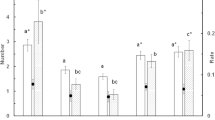Abstract
Foraging behaviour of bats is supposedly largely influenced by the high costs of flapping flight. Yet our understanding of flight energetics focuses mostly on continuous horizontal forward flight at intermediate speeds. Many bats, however, perform manoeuvring flights at suboptimal speeds when foraging. For example, members of the genus Rhinolophus hunt insects during short sallying flights from a perch. Such flights include many descents and ascents below minimum power speed and are therefore considered energetically more expensive than flying at intermediate speed. To test this idea, we quantified the energy costs of short manoeuvring flights (<2 min) using the Na-bicarbonate technique in two Rhinolophus species that differ in body mass but have similar wing shapes. First, we hypothesized that, similar to birds, energy costs of short flights should be higher than predicted by an equation derived for bats at intermediate speeds. Second, we predicted that R. mehelyi encounters higher flight costs than R. euryale, because of its higher wing loading. Although wing loading of R. mehelyi was only 20% larger than that of R. euryale, its flight costs (2.61 ± 0.75 W; mean ± 1 SD) exceeded that of R. euryale (1.71 ± 0.37 W) by 50%. Measured flight costs were higher than predicted for R. mehelyi, but not for R. euryale. We conclude that R. mehelyi face elevated energy costs during short manoeuvring flights due to high wing loading and thus may optimize foraging efficiency by energy-conserving perch-hunting.



Similar content being viewed by others
References
Aldridge HDJN, Rautenbach IL (1987) Morphology, echolocation and resource partitioning in insectivorous bats. J Anim Ecol 56:763–778
Audet D, Krull D, Marimuthu G, Sumithran S, Singh JB (1991) Foraging behavior of the Indian False Vampire Bat, Megaderma lyra (Chiroptera: Megadermatidae). Biotropica 23:63–67
Butler PJ, Bishop CM (1999) Costs of short flights in the willow tit measured by doubly labelled water. Auk 109:389–393
Cerling TE, Ayliffe LK, Dearing MD, Ehleringer JR, Passey BH, Podelsack DW, Torregrossa A, West AG (2007) Determining biological tissue turnover using stable isotopes: the reaction progress variable. Oecologia 151:175–189
Dietz C (2007) Aspects of ecomorphology in the five European horseshoe bats (Chiroptera: Rhinolophidae) in the area of sympatry. Doctoral dissertation, University of Tübingen, Germany
Dietz C, Dietz I, Siemers BM (2006) Wing measurement variations in the five European horseshoe bat species (Chiroptera: Rhinolophidae. J Mammal 87:1241–1251
Dietz C, von Helversen O, Nill D (2009) Bats of Britain, Europa and Northwest Africa. A & C Black Publishers, United Kingdom
Fenton MB (1990) The foraging behaviour and ecology of animal-eating bats. Can J Zool 68:411–422
Findley JS, Black H (1983) Morphological and dietary structuring of Zambian insectivorous bat community. Ecology 64:625–630
Findley JS, Wilson DE (1982) Ecological significance of chiropteran morphology. In: Kunz TH (ed) Ecology of bats. Plenum, New York, pp 243–260
Hambly C, Harper EJ, Speakman JR (2002) Cost of flight in the zebra finch (Taenopygia guttata).: a novel approach based on elimination of 13C labelled bicarbonate. J Comp Physiol B 172:529–539
Hambly C, Harper EJ, Speakman JR (2004a) The energy cost of loaded flight is substantially lower than expected due to alterations in flight kinematics. J Exp Biol 207:3969–3976
Hambly C, Pinshow B, Wiersma P, Verhulst S, Piertney SB, Harper EJ, Speakman JR (2004b) Comparison of the cost of short flights in a nectarivorous and a non-nectarivorous bird. J Exp Biol 207:3959–3968
Heller K-G, von Helversen O (1989) Resource partitioning of sonar frequency bands in rhinolophid bats. Oecologia 80:178–186
Jones G, Rayner JMV (1989) Foraging behavior and echolocation of wild horseshoe bats Rhinolophus ferrumequinum and R. hipposideros (Chiroptera, Rhinolophidae). Behav Ecol Sociobiol 25:183–191
Kalcounis MC, Brigham RM (1995) Intraspecific variation in wing loading affects habitat use by little brown bats Myotis lucifugus. Can J Zool 73:89–95
Kalko EKV, Friemel D, Handley CO Jr, Schnitzler HU (1999) Roosting and foraging behavior of two neotropical gleaning bats, Tonatia silvicola and Trachops cirrhosus (Phyllostomidae). Biotropica 31:344–353
Kingston T, Jones G, Zubaid A, Kunz TH (2000) Resource partitioning in rhinolophoid bats revisited. Oecologia 124:332–342
Kingston T, Lara MC, Jones G, Zubaid A, Kunz TH, Schneider CJ (2001) Acoustic divergence in two cryptic Hipposideros species: a role for social selection? Proc R Soc Lond B 268:1381–1386
Lasiewski RC (1963) Oxygen consumption of torpid, resting, active, and flying hummingbirds. Physiol Zool 36:122–140
Lighton JRB (2008) Measuring metabolic rates—a manual for scientists. Oxford University Press, Oxford
Masman D, Klaassen M (1987) Energy expenditure during free flight in trained and free-living Eurasian kestrels (Falco tinnunculus). Auk 104:603–616
Neuweiler G, Metzner W, Heilmann U, Rübsamen R, Eckrich M, Costa HH (1987) Foraging behaviour and echolocation in the rufous horseshoe bat (Rhinolopus rouxi) of Sri Lanka. Behav Ecol Sociobiol 20:53–67
Norberg UM, Rayner JMV (1987) Ecological morphology and flight in bats (Mammalia; Chiroptera): wing adaptations, flight performance, foraging strategy and echolocation. Phil Trans R Soc Lond B 316:335–427
Nudds RL, Bryant DM (2000) The energetic cost of short flights in birds. J Exp Biol 203:1561–1572
Russo D, Almenar D, Aihartza J, Goiti U, Salzamendi E, Garin I (2005) Habitat selection in sympatric Rhinolophus mehelyi and R. euryale (Mammalia: Chiroptera). J Zool (Lond) 266:327–332
Safi K, Siemers BM (2010) Implications of sensory ecology for species coexistence: biased perception links predator diversity to prey size distribution. Evol Ecol. doi:10.1007/s10682-009-9326-0
Salsamendi E, Aihartza J, Goiti U, Almenar D, Garin I (2005) Echolocation calls and morphology in the Mehely’s (Rhinolophus mehelyi). and Mediterranean (R. euryale). horseshoe bats: implications for resource partitioning. Hystrix Ital J Mammal (ns) 16:149–158
Schmidt-Nielsen K (1984) Animal physiology—adaptation and environment. Cambridge Univ Press, Cambridge
Schnitzler H-U, Kalko EKV (2001) Echolocation by insect-eating bats. Bioscience 51:557–569
Schnitzler H-U, Moss CF, Denzinger A (2003) From spatial orientation to food acquisition in echolocating bats. Trends Ecol Evol 18:386–394
Siemers BM, Ivanova T (2004) Ground gleaning in horseshoe bats: comparative evidence from Rhinolophus blasii, R. euryale and R. mehelyi. Behav Ecol Sociobiol 56:464–471
Siemers BM, Schnitzler H-U (2004) Echolocation signals reflect niche differentiation in five sympatric congeneric bats. Nature 429:657–661
Simmons NB (2005) Order Chiroptera. In: Wilson DE, Reeder DM (eds) Mammal species of the world: a taxonomic and geographic reference, vol 1, 3rd edn. Johns Hopkins University Press, USA, pp 312–529
Speakman JR (1997) The doubly labelled water method. Chapman and Hall, London
Speakman JR, Racey PA (1991) No cost of echolocation for bats in flight. Nature 350:421–423
Speakman JR, Thomas DW (2003) Physiological ecology and energetics of bats. In: Kunz TH, Fenton BM (eds) Bat ecology. The University of Chicago Press, Chicago, pp 430–492
Speakman JR, Thomson SC (1997) Validation of the labelled bicarbonate technique for measurement of short-term energy expenditure in the mouse. Z Ernährungswiss 36:273–277
Speakman JR, Lancaster WC, Ward S, Jones G, Cole K (2001) The energy costs of echolocation in stationary bats. In: Thomas (ed) Proc. 4th Int Biosonar Conf, Carviero, Portugal, April 1998. Chicago University Press, Chicago
Thomas SP (1975) Metabolism during flight of two species of bats, Phyllostomus hastatus and Pteropus gouldii. J Exp Biol 63:273–292
Tucker VA (1968) Bird metabolism during flight: evaluation and theory. J Exp Biol 58:689–709
Voigt CC (2000) Intraspecific scaling of flight power in the bat Glossophaga soricina (Phyllostomidae). J Comp Physiol B 170:403–410
Voigt CC, Winter Y (1999) The energy costs of hovering flight in nectar-feeding bats (Phyllomidae: Glossophaginae) and its scaling in moths, birds, and bats. J Comp Physiol B 169:38–48
Voigt CC, Sörgel K, Dechmann DKN (2010) Refuelling while flying: Insectivorous bats combust food rapidly and directly to fuel flight. Ecology. doi:10.1890/09-2232
Ward S, Moller U, Rayner JMV, Jackson DM, Bilo D, Nachtigall W, Speakman JR (2001) Metabolic power, mechanical power and efficiency during wind tunnel flight by European starlings Sturnus vulgaris. J Exp Biol 204:3311–3322
Winter Y, von Helversen O (1998) The energy cost of flight: do small bats fly more cheaply than birds? J Comp Physiol B 168:105–111
Acknowledgments
We thank Ivailo Borissov for his company and help during the experiments. We are most grateful to Karin Sörgel for analysing the breath samples in the stable isotope laboratory of the IZW. Doris Fichte kindly quantified the wing morphology data for us and Sara Troxell kindly scored the exact flight times. We thank J.R. Speakman for advice regarding the Na-bicarbonate technique, Ulla Lindhe for comments on an earlier draft of this manuscript and Dietmar Nill for allowance to use his Fig. 1. Also, we thank the responsible Bulgarian authorities for granting us permission to conduct this research and the Directorate of the Rusenski Lom Nature Park (director Milko Belberov) for support. We are grateful to the people of Bulgaria, in particular those of Tabachka, for their kindness and hospitality.
Author information
Authors and Affiliations
Corresponding author
Additional information
Communicated by G. Heldmaier.
Rights and permissions
About this article
Cite this article
Voigt, C.C., Schuller, BM., Greif, S. et al. Perch-hunting in insectivorous Rhinolophus bats is related to the high energy costs of manoeuvring in flight. J Comp Physiol B 180, 1079–1088 (2010). https://doi.org/10.1007/s00360-010-0466-x
Received:
Revised:
Accepted:
Published:
Issue Date:
DOI: https://doi.org/10.1007/s00360-010-0466-x




